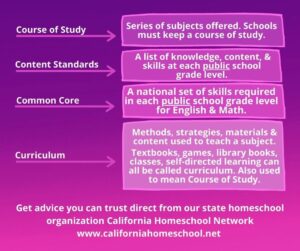School records are considered confidential information and should never be relinquished unless a child transfers to another school. Although private schools are not required to submit records to the state, they are required to keep certain records in their files, as outlined in the California Education Code.
The records a private school must keep on file include:
- Copy of the completed Private School Affidavit (PSA).
- Attendance record, indicating days absent. Some homeschoolers use a calendar.
- Faculty qualifications and addresses. Private school teachers need not hold a teaching credential, but must be “capable of teaching.”
- The courses of study offered by the institution. Some will do it for their entire school, and others for each child or grade taught. Refer to the branches of study below to create your own.

- California’s immunization law changed in 2014 and then again in 2016. While children enrolled in public or private schools will no longer be allowed to submit a personal beliefs exemption or waiver, home based private schools are exempt. Immunization records are still required to be in a student file. For more information about immunizations, or to download the immunization record form for your file here: cdph286 Immunization Form.
- For first graders only, there is a “Health Exam for School Entry” form or waiver.
- For new and updated resources on school immunization, ShotsForSchool.org provides the following resources list that many find helpful when reviewing records. The first one may be the most helpful for checking immunization requirements for school admission.
- Tool for Determining Admission Status K-12 (new!)
- California Immunization Handbook (aka Blue Book)
- Guide to Immunizations Required for School Entry | Spanish
- Parents’ Guide to Immunizations Required for School Entry | Spanish | Chinese | Russian
- Letter to Parents: Immunizations Needed | Spanish
- Vaccine Acronyms and Abbreviations (new!)
- Senate Bill 277 Frequently Asked Questions | Spanish | Russian
Cumulative File
In addition to your required school records, you may want to develop a cumulative file for each student. If your child ever transfers from your homeschool, the new school will request a cumulative file. The following are some suggestions of some items that might be found in a cumulative file. What you choose to put in it is up to you:
- Legal name of student.
- Date of birth, place of birth and verification of birth date.
- Sex of pupil.
Placing a copy of the birth certificate in the file would provide the above information. - Name and address of parent of minor pupil.
- Entering and leaving date of each school year.
- Subjects taken during each year your child is in your school.
- Marks, grades, or credits, if given. Grades or report cards are not required.
- For high school students, include a current high school transcript, and California High School Proficiency Exam (CHSPE) or GED, if applicable.
Other Records, Forms and Requirements
Parents working exclusively with their own children are not required to undergo FBI criminal background checks (fingerprinting) as is required of classroom teachers. They also do not need a TB test for homeschooling purposes.
REQUIRED BRANCHES OF STUDY
Below is a list from the California Education Code of courses private schools must offer to their students. Students are not required to take all of these courses.
Grades 1-6
The adopted course of study for grades 1 to 6 shall include instruction, beginning in grade 1 and continuing through grade 6, in the following areas of study:
- English, including knowledge of, and appreciation for literature and the language, as well as the skills of speaking, reading, listening, spelling, handwriting, and composition.
- Mathematics, including concepts, operational skills, and problem solving.
- Social sciences, drawing upon the disciplines of anthropology, economics, geography, history, political science, psychology, and sociology, designed to fit the maturity of the pupils. Instruction shall provide a foundation for understanding the history, resources, development, and government of California and the United States of America; the development of the American economic system including the role of the entrepreneur and labor; man’s relations to his human and natural environment; eastern and western cultures and civilizations; contemporary issues; and the wise use of natural resources.
- Science, including the biological and physical aspects, with emphasis on the processes of experimental inquiry and on man’s place in ecological systems.
- Fine arts, including instruction in the subjects of art and music, aimed at the development of aesthetic appreciation and the skills of creative expression.
- Health, including instruction in the principles and practices of individual, family, and community health
- Physical education, with emphasis upon the physical activities for the pupils that may be conducive to health and vigor of body and mind, for a total period of time of not less than 200 minutes each 10 school days, exclusive of recesses and the lunch period.
Grades 7-12
The adopted course of study for grades 7 to 12, inclusive, shall offer courses in the following areas of study:
- English, including knowledge of and appreciation for literature, language, and composition, and the skills of reading, listening, and speaking.
- Social sciences, drawing upon the disciplines of anthropology, economics, geography, history, political science, psychology, and sociology, designed to fit the maturity of the pupils. Instructions shall provide a foundation for understanding the history, resources, development, and government of California and the United States of America; instruction in our American legal system, the operation of the juvenile and adult criminal justice systems, and the rights and duties of citizens under the criminal and civil law and the State and Federal Constitutions; the development of the American economic system, including the role of the entrepreneur and labor; the relations of persons to their human and natural environment; eastern and western cultures and civilizations; human rights issues, with particular attention to the study of the inhumanity of genocide, slavery, and the Holocaust, and contemporary issues.
- Foreign language or languages, beginning not later than grade 7, designed to develop a facility for understanding, speaking, reading, and writing the particular language.
- Physical education, with emphasis given to physical activities that are conducive to health and to vigor of body and mind.
- Science, including the physical and biological aspects, with emphasis on basic concepts, theories, and processes of scientific investigation and on the place of humans in ecological systems, and with appropriate applications of the interrelation and interdependence of the sciences.
- Mathematics, including instruction designed to develop mathematical understandings, operational skills, and insight into problem-solving procedures.
- Fine arts, including art, music, or drama, with emphasis upon development of aesthetic appreciation and the skills of creative expression.
- Applied arts, including instruction in the areas of consumer and homemaking education, industrial arts, general business education, or general agriculture.
- Vocational-technical education designed and conducted for the purpose of preparing youth for gainful employment in the occupations and in the numbers that are appropriate to the personnel needs of the state and the community served and relevant to the career desires and needs of the pupils.
- Automobile driver education, designed to develop a knowledge of the provisions of the Vehicle Code and other laws of this state relating to the operation of motor vehicles, a proper acceptance of personal responsibility in traffic, a true appreciation of the causes, seriousness and consequences of traffic accidents, and to develop the knowledge and attitudes necessary for the safe operation of motor vehicles. A course in automobile driver education shall include education in the safe operation of motorcycles.
- Other studies as may be prescribed by the governing board.
